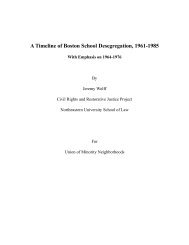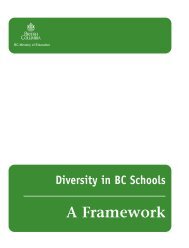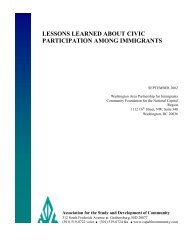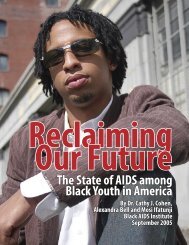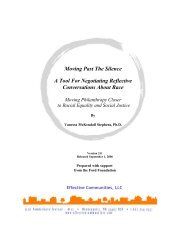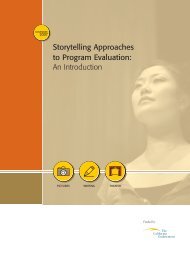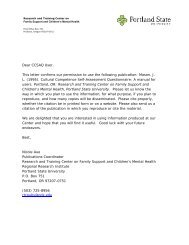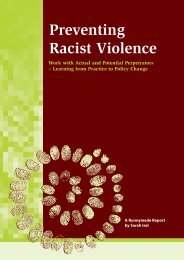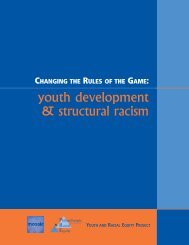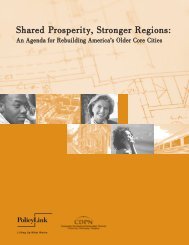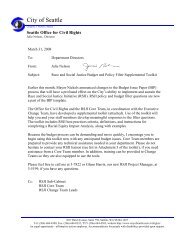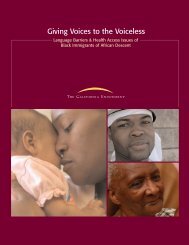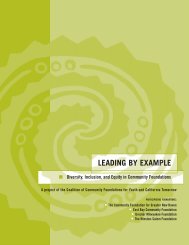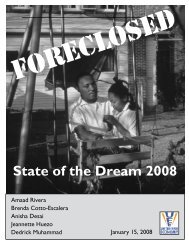REGIONAL OPPORTUNITYwith<strong>in</strong> walk<strong>in</strong>g distance <strong>of</strong> transit. TOD projects<strong>in</strong>crease the density <strong>of</strong> people near transit, <strong>in</strong>clud<strong>in</strong>gresidents, employees, visitors, <strong>and</strong> customers, <strong>in</strong> abuilt environment that is pedestrian-friendly <strong>and</strong>connected to transit. Mixed-use build<strong>in</strong>gs, projects,or areas with a mix <strong>of</strong> uses are active from early <strong>in</strong> themorn<strong>in</strong>g to late <strong>in</strong> the even<strong>in</strong>g, mak<strong>in</strong>g theenvironment safer for pedestrians <strong>and</strong> provid<strong>in</strong>g peak<strong>and</strong> <strong>of</strong>f-peak customers for transit service. A TODmay be a s<strong>in</strong>gle build<strong>in</strong>g, a group <strong>of</strong> build<strong>in</strong>gs, or amultiple block district.”Transit-oriented development is not exceptional,either today or <strong>in</strong> the past. In a certa<strong>in</strong> era, it was acommon development pattern, as neighborhoodsclustered around subway stations, streetcar l<strong>in</strong>es, <strong>and</strong>the like. After a period <strong>of</strong> decl<strong>in</strong>e which co<strong>in</strong>cidedwith the growth <strong>in</strong> auto use <strong>and</strong> suburban sprawl,TOD experienced a 1990s revival <strong>in</strong> response toadvocacy for smarter growth policies, exp<strong>and</strong>edtransit systems, <strong>and</strong> the drive for central cityrevitalization. What rema<strong>in</strong>s exceptional are TODprojects that mean<strong>in</strong>gfully anticipate their potentialgentrify<strong>in</strong>g impacts <strong>and</strong>, therefore, develop antidisplacementmechanisms <strong>in</strong> an <strong>in</strong>clusive <strong>and</strong>community-based process.Historically, new developments (transit-oriented orotherwise)—particularly subsidized developments<strong>in</strong> <strong>in</strong>ner-city communities—spur a familiar pattern<strong>of</strong> displacement <strong>and</strong> gentrification. Public<strong>in</strong>vestment canmotivate a greaterWhat rema<strong>in</strong>s exceptional <strong>in</strong>vestment fromare TOD projects that the private sectormean<strong>in</strong>gfully anticipate their <strong>and</strong> attract newpotential gentrify<strong>in</strong>g impactsresidents to apreviously<strong>and</strong>, therefore, develop antidisplacementmechanisms neighborhood. Thisdis<strong>in</strong>vested<strong>in</strong> an <strong>in</strong>clusive <strong>and</strong> <strong>in</strong>creasedcommunity-based process. desirability feeds aquick run-up <strong>in</strong>l<strong>and</strong> values <strong>and</strong>related costs (e.g., rents, property taxes). S<strong>in</strong>glefamilyrentals are sold <strong>and</strong> converted tohomeownership <strong>and</strong> subst<strong>and</strong>ard properties arerazed or improved so as to meet the dem<strong>and</strong>s <strong>of</strong> thenew, higher-<strong>in</strong>come residents. Exist<strong>in</strong>g residents aresubjected to multiple displac<strong>in</strong>g pressures <strong>and</strong>exist<strong>in</strong>g bus<strong>in</strong>esses/employers face ris<strong>in</strong>g operat<strong>in</strong>gexpenses <strong>and</strong> the loss <strong>of</strong> their customer base.Affordable rental property, residential orcommercial, becomes harder to f<strong>in</strong>d. To somedegree, displacement <strong>and</strong> gentrification result fromexclusive decisionmak<strong>in</strong>g. It is more likely <strong>and</strong> moreextensive where potentially affected communityresidents, particularly those most at risk <strong>of</strong>displacement (low-<strong>in</strong>come people, people <strong>of</strong> color,the elderly, the disabled, <strong>and</strong> small bus<strong>in</strong>esses) lackmean<strong>in</strong>gful opportunities to access <strong>and</strong> <strong>in</strong>fluencedevelopment decisions. In their absence, suchdecisionmak<strong>in</strong>g is less likely to prioritize an antidisplacementagenda.The East Harlem Community L<strong>in</strong>k InitiativeIt is aga<strong>in</strong>st this backdrop that the <strong>Regional</strong> PlanAssociation (RPA), an <strong>in</strong>dependent, not-for-pr<strong>of</strong>itregional plann<strong>in</strong>g organization, strives to improve thequality <strong>of</strong> life <strong>and</strong> economic competitiveness <strong>in</strong> the31-county New York-New Jersey-ConnecticutRegion through research, plann<strong>in</strong>g, <strong>and</strong> advocacy.Released <strong>in</strong> 1996, RPA’s Third <strong>Regional</strong> Plan, “ARegion at Risk,” called for build<strong>in</strong>g a seamless 21 stcentury mass transit system, creat<strong>in</strong>g a three millionacreGreensward network <strong>of</strong> protected naturalresource systems, ma<strong>in</strong>ta<strong>in</strong><strong>in</strong>g half <strong>of</strong> the region’semployment <strong>in</strong> urban centers, <strong>and</strong> assist<strong>in</strong>g m<strong>in</strong>ority<strong>and</strong> immigrant communities to fully participate <strong>in</strong>the economic ma<strong>in</strong>stream.A key recommendation <strong>of</strong> RPA’s plan was the revival<strong>of</strong> the long-dormant Second Avenue Subway project<strong>in</strong> the East Harlem neighborhood <strong>of</strong> New York City.Proposals to build a north-south subway l<strong>in</strong>e alongSecond Avenue date back to 1929, with several plans<strong>and</strong> false starts <strong>in</strong> the follow<strong>in</strong>g decades. Fastforward to 1995, the Metropolitan TransportationAuthority (MTA) began the Manhattan East SideAlternatives (MESA) Study. The MESA study teamcompiled a list <strong>of</strong> more than 20 alternatives toresolve exist<strong>in</strong>g <strong>and</strong> future transportation issuesidentified with<strong>in</strong> the study area, but proposed ashortened version that would fail to connect manylow-<strong>in</strong>come communities to job opportunities <strong>in</strong>downtown Manhattan. The <strong>Regional</strong> PlanAssociation <strong>and</strong> its allies commenced acomprehensive, successful campaign <strong>in</strong>volv<strong>in</strong>gadvertis<strong>in</strong>g <strong>and</strong> local elected <strong>of</strong>ficials, <strong>and</strong> the MTAboard eventually allocated $1.05 billion <strong>in</strong> its 2000-2004 Capital Program to complete the plann<strong>in</strong>g <strong>and</strong>design <strong>and</strong> <strong>in</strong>itiate construction <strong>of</strong> a full-lengthSecond Avenue Subway.101Funders’ Network for Smart Growth <strong>and</strong> Livable Communities
The <strong>Regional</strong> Plan Association then launched its EastHarlem Community L<strong>in</strong>k Initiative. Supported bythe Ford Foundation, it began work<strong>in</strong>g then with theEast Harlem community to design <strong>and</strong> implement astrategy aimed at counter<strong>in</strong>g potential exclusion <strong>and</strong>displacement. This part <strong>of</strong> Harlem, also known as“El Barrio,” is the traditional heart <strong>of</strong> New YorkCity’s Puerto Rican community. It is now home to adiverse mix <strong>of</strong> Puerto Ricans, more recent Lat<strong>in</strong>oimmigrants, <strong>and</strong> African Americans, <strong>and</strong> hasexperienced <strong>in</strong>creas<strong>in</strong>g gentrification pressures s<strong>in</strong>cethe late 1990s. The East Harlem Community L<strong>in</strong>kInitiative is designed to strengthen the community’svoice <strong>in</strong> plann<strong>in</strong>g for subway construction <strong>and</strong> toensure that result<strong>in</strong>g development benefits localresidents <strong>and</strong> bus<strong>in</strong>esses.An early success was w<strong>in</strong>n<strong>in</strong>g approval for a station atthe crossroads <strong>of</strong> East Harlem. The MTA’s plansorig<strong>in</strong>ally called for Second Avenue Subway stationsat 96 th Avenue, 106 thAvenue, <strong>and</strong> 125 thThe East Harlem Community Avenue. In thisL<strong>in</strong>k Initiative is designed to configuration, therestrengthen the community’s would be no stationvoice <strong>in</strong> plann<strong>in</strong>g for subway for almost 20blocks, a stretchconstruction <strong>and</strong> to ensurewhich <strong>in</strong>cludedthat result<strong>in</strong>g development116 th Avenue,benefits local residents <strong>and</strong> historically thebus<strong>in</strong>esses.ma<strong>in</strong> commercialstrip for EastHarlem. Aga<strong>in</strong>, theEast Harlem Community L<strong>in</strong>k Initiative, led byRPA, was at the center <strong>of</strong> a successful campaign<strong>in</strong>volv<strong>in</strong>g elected <strong>of</strong>ficials, community <strong>in</strong>terests, <strong>and</strong>media to add a station at 116 th Avenue.Fruitvale Transit VillageThe second project <strong>in</strong> this pr<strong>of</strong>ile is The UnityCouncil’s Fruitvale Transit Village (Fruitvale Village).Fruitvale is a highly diverse, <strong>in</strong>ner-city neighborhood<strong>in</strong> Oakl<strong>and</strong>, Calif. Though predom<strong>in</strong>antly Lat<strong>in</strong>o,people <strong>of</strong> many nationalities reside there (Ch<strong>in</strong>ese,Laotian, Pakistani, Filip<strong>in</strong>o, Eastern European) <strong>and</strong>47 percent <strong>of</strong> neighborhood residents were bornoutside <strong>of</strong> the United States. It is also aneighborhood that has struggled under the weights<strong>of</strong> segregation <strong>and</strong> concentrated poverty. In 1990,Bay Area Rapid Transit (BART) <strong>of</strong>ficials developed aplan for a park<strong>in</strong>g garage adjacent to an exist<strong>in</strong>gBART station without mean<strong>in</strong>gful community<strong>in</strong>volvement. Fruitvale community membersobjected to the garage’s location <strong>and</strong> set thefoundation for an ongo<strong>in</strong>g community-basedrevitalization effort centered around the BARTstation <strong>and</strong> transit-oriented development, whichevolved <strong>in</strong>to the Fruitvale Village Project.S<strong>in</strong>ce its <strong>in</strong>ception <strong>in</strong> 1993, the Fruitvale VillageProject has evolved <strong>in</strong>to an excit<strong>in</strong>g model for <strong>in</strong>nercityredevelopment which will support a number <strong>of</strong>amenities: commercial/retail shopp<strong>in</strong>g area, largepedestrian plaza, <strong>and</strong> comprehensive communityservices rang<strong>in</strong>g from health care to child care. It hasbecome a national model <strong>of</strong> smarter growthpractices, transit-oriented development, <strong>and</strong>community-based plann<strong>in</strong>g. With the assistance <strong>of</strong>the Fruitvale Development Corporation, a supportcorporation <strong>of</strong> The Unity Council, the Village willalso house The Unity Council’s headquarters, apublic library, several community organizations, acomputer technology center, a senior center, <strong>and</strong> 47units <strong>of</strong> hous<strong>in</strong>g. The goal <strong>of</strong> the Village is to work <strong>in</strong>coord<strong>in</strong>ation with the Fruitvale Ma<strong>in</strong> Street Program(an effort to make the Fruitvale district safer, clean,attractive, <strong>and</strong> economically successful) to revitalizethe Fruitvale commercial corridor. The effort is tol<strong>in</strong>k this diverse community <strong>and</strong> thous<strong>and</strong>s <strong>of</strong> dailycommuters to the services, bus<strong>in</strong>esses, <strong>and</strong> variousmodes <strong>of</strong> transportation <strong>of</strong>fered by the Fruitvaleneighborhood.The mission <strong>of</strong> The Unity Council is to help buildthe assets <strong>of</strong> families <strong>and</strong> low-<strong>in</strong>come communitiesthrough a comprehensive program <strong>of</strong> susta<strong>in</strong>ablephysical, economic, <strong>and</strong> social development. TheCouncil, formerly called The Spanish Speak<strong>in</strong>g UnityCouncil, was founded <strong>in</strong> 1964, <strong>in</strong>corporated <strong>in</strong>1967, <strong>and</strong> received 501(c)(3) tax-exempt status <strong>in</strong>1968. S<strong>in</strong>ce that time, the Council has been anonpr<strong>of</strong>it community development organizationcommitted to enrich<strong>in</strong>g the quality <strong>of</strong> life <strong>of</strong> familiesprimarily <strong>in</strong> the Fruitvale District <strong>of</strong> Oakl<strong>and</strong>. Itsprimary focus has been to create a healthier <strong>and</strong> safercommunity for families <strong>and</strong> residents.Funder InterestAccord<strong>in</strong>g to the Ford Foundation’s act<strong>in</strong>g director <strong>of</strong>the Community <strong>and</strong> Resource Development Unit,Carl Anthony, the Foundation recognized that the<strong>Regional</strong> Plan Association was one <strong>of</strong> the nation’sREGIONAL OPPORTUNITYPart III: Section 3: Connect<strong>in</strong>g to <strong>Regional</strong> Opportunity 102
- Page 1 and 2:
Stories of Philanthropic Leadership
- Page 3 and 4:
Signs of Promise:Stories of Philant
- Page 5 and 6:
Funders’ Network for Smart Growth
- Page 7 and 8:
(II. B.)(II. C.)Turning Neighborhoo
- Page 9 and 10:
PART I:IntroductionThe Purpose of t
- Page 11 and 12:
social justice issues as they relat
- Page 13 and 14:
PART II:Perspectives on Advancing R
- Page 15 and 16:
peer work, we can reestablish a sig
- Page 17 and 18:
Annie E. Casey FoundationBaltimore,
- Page 19 and 20:
neighborhoods into healthy ones—g
- Page 21 and 22:
Charles and Helen Schwab Foundation
- Page 23 and 24:
Section 1:Promoting Equitable Publi
- Page 25 and 26:
I. A. BUILDING POWER AND GIVINGVOIC
- Page 27 and 28:
policy advocates. In 2002, Milwauke
- Page 29 and 30:
in Los Angeles, Ford’s Anthony no
- Page 31 and 32:
I. B. PROMOTING COALITIONSTO ADVANC
- Page 33 and 34:
Yet the interpersonal dynamics of c
- Page 35 and 36:
guidelines. “Many of the member o
- Page 37 and 38:
Funder InterestThe EPA supported th
- Page 39 and 40:
I. D. DEMONSTRATING THESTRUGGLE FOR
- Page 41 and 42:
Richmond, Calif.The second regional
- Page 43 and 44:
through policy reform at the local
- Page 45 and 46:
I. E. BUILDING COALITIONTHROUGH KNO
- Page 47 and 48:
organizing project, the Connecticut
- Page 49 and 50:
and businesses are quantified in a
- Page 51 and 52:
I. G. REVITALIZING WHILEASSURING DI
- Page 53 and 54:
In the late 1990s, the city of Albu
- Page 55 and 56:
I. H. A TRAVEZ DE LA FRONTERA:LAND
- Page 57 and 58: The International Community Foundat
- Page 59 and 60: I. I. MOBILIZING ACTION FORREGIONAL
- Page 61 and 62: To meet all of these objectives, th
- Page 63 and 64: efforts. And with each public plann
- Page 65 and 66: pattern of disproportionate transpo
- Page 67 and 68: Clinica de la Raza identify this cr
- Page 69 and 70: Contact PeopleCarl AnthonyActing Di
- Page 71 and 72: Section 2:Making All Neighborhoods
- Page 73 and 74: II. A. REACHING BEYONDHOUSING TO IM
- Page 75 and 76: A local resident receives the keys
- Page 77 and 78: East Baltimore community and the Jo
- Page 79 and 80: example, adjacent to the EBDI area,
- Page 81 and 82: II. C. YIELDING REGIONALBENEFITS TH
- Page 83 and 84: is using transit-oriented developme
- Page 85 and 86: financing and innovative, forward-t
- Page 87 and 88: The Row House Community Development
- Page 89 and 90: II. E. COUNTERING THE PERFECTSTORM:
- Page 91 and 92: funded community programs, includin
- Page 93 and 94: housing developments and commercial
- Page 95 and 96: owned enterprises, totaling $8.5 mi
- Page 97 and 98: LOAN GUARANTEESSection 3:Connecting
- Page 99 and 100: III. A. MAKING HOUSING ANOPPORTUNIT
- Page 101 and 102: A new report from the National Hous
- Page 103 and 104: The Straphangers Campaign was found
- Page 105 and 106: Funder InterestThe Straphangers Cam
- Page 107: or increase poverty. Whether direct
- Page 111 and 112: multi-stakeholder effort composed o
- Page 113 and 114: director with LISC. No one set of s
- Page 115 and 116: 12 western Louisville neighborhoods
- Page 117 and 118: III. E. UNITING THREE STATESFOR ONE
- Page 119 and 120: increased their personal wealth by
- Page 121 and 122: summary evaluation of MSDI found th
- Page 123 and 124: method alone was strong enough to m
- Page 125 and 126: consistent body of work. The Counci
- Page 127 and 128: 3) Issues Need to be ConnectedThe f
- Page 129 and 130: PART V:Glossary of TermsThe terms d
- Page 131 and 132: Regional and neighborhood equity. A
- Page 133 and 134: Tijuana River Reserve, California:h
- Page 135 and 136: Sargent Shriver National Center on
- Page 137: 1500 San Remo Avenue • Suite 249



